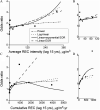The Diesel Exhaust in Miners Study (DEMS) II: Temporal Factors Related to Diesel Exhaust Exposure and Lung Cancer Mortality in the Nested Case-Control Study
- PMID: 37549095
- PMCID: PMC10406174
- DOI: 10.1289/EHP11980
The Diesel Exhaust in Miners Study (DEMS) II: Temporal Factors Related to Diesel Exhaust Exposure and Lung Cancer Mortality in the Nested Case-Control Study
Abstract
Background: The Diesel Exhaust in Miners Study (DEMS) was an important contributor to the International Agency for Research on Cancer reclassification of diesel exhaust as a Group I carcinogen and subsequent risk assessment. We extended the DEMS cohort follow-up by 18 y and the nested case-control study to include all newly identified lung cancer deaths and matched controls (DEMS II), nearly doubling the number of lung cancer deaths.
Objective: Our purpose was to characterize the exposure-response relationship with a focus on the effects of timing of exposure and exposure cessation.
Methods: We conducted a case-control study of lung cancer nested in a cohort of 12,315 workers in eight nonmetal mines (376 lung cancer deaths, 718 controls). Controls were selected from workers who were alive when the case died, individually matched on mine, sex, race/ethnicity, and birth year (within 5 y). Based on an extensive historical exposure assessment, we estimated respirable elemental carbon (REC), an index of diesel exposure, for each cohort member. Odds ratios (ORs) were estimated by conditional regression analyses controlling for smoking and other confounders. To evaluate time windows of exposure, we evaluated the joint OR patterns for cumulative REC within each of four preselected exposure time windows, , 5-9, 10-19, and y prior to death/reference date, and we evaluated the interaction of cumulative exposure across time windows under additive and multiplicative forms for the joint association.
Results: ORs increased with increasing 15-y lagged cumulative exposure, peaking with a tripling of risk for exposures of [; 95% confidence interval (CI): 1.47, 7.10], followed by a plateau/decline among the heavily exposed (; 95% CI: 0.85, 4.04). Patterns of risk by cumulative REC exposure varied across four exposure time windows (), with ORs increasing for exposures accrued primarily 10-19 y prior to death (). Results provided little support for a waning of risk among workers whose exposures ceased for y.
Conclusion: DEMS II findings provide insight into the exposure-response relationship between diesel exhaust and lung cancer mortality. The pronounced effect of exposures occurring in the window 10-19 y prior to death, the sustained risk 20 or more years after exposure ceases, and the plateau/decline in risk among the most heavily exposed provide direction for future research on the mechanism of diesel-induced carcinogenesis in addition to having important implications for the assessment of risk from diesel exhaust by regulatory agencies. https://doi.org/10.1289/EHP11980.
Figures


Comment in
-
Invited Perspective: Diesel Exhaust and Lung Cancer-Delayed Findings Confirmed, but Consequences Continue.Environ Health Perspect. 2023 Aug;131(8):81301. doi: 10.1289/EHP13258. Epub 2023 Aug 7. Environ Health Perspect. 2023. PMID: 37549096 Free PMC article. No abstract available.
References
-
- Vermeulen R, Coble JB, Yereb D, Lubin JH, Blair A, Portengen L, et al. 2010. The Diesel Exhaust in Miners Study: III. Interrelations between respirable elemental carbon and gaseous and particulate components of diesel exhaust derived from area sampling in underground non-metal mining facilities. Ann Occup Hyg 54(7):762–773, PMID: , 10.1093/annhyg/meq023. - DOI - PMC - PubMed
-
- Vermeulen R, Coble JB, Lubin JH, Portengen L, Blair A, Attfield MD, et al. 2010. The Diesel Exhaust in Miners Study: IV. Estimating historical exposures to diesel exhaust in underground non-metal mining facilities. Ann Occup Hyg 54(7):774–788. Oct, PMID: , 10.1093/annhyg/meq025. - DOI - PMC - PubMed
Publication types
MeSH terms
Substances
LinkOut - more resources
Full Text Sources
Medical

